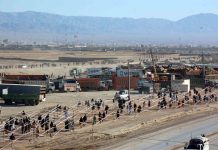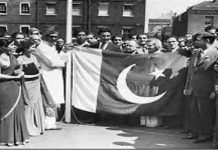Peshawar: For a strategy that is meant to put a stop to terrorism, the National Action Plan may have become a controversial subject reinforcing the civil-military divide in Pakistan. But for the journalists in the border areas, the P in NAP signifies something more than a plan – it means a peril.
Article 11 of NAP that was jointly initiated by the military and the civilian government after the attacks on the Army Public School in Peshawar in December 2014 puts a “ban on glorification of terrorism and terrorist organizations through print and electronic media.”
For journalists, the article translates into this:Media will not be allowed to give any space to terrorists. Within a year of NAP, at least one journalist has been killed for not covering militants’ versions in stories and several others threatened by groups affiliated to the Taliban.
While accepting responsibility for killing Zaman Mehsud, a journalist who worked for the Urdu Daily Umat and SANA, Taliban commander Qari Siaf Ullah Saif threatened other journalists in the region saying, “we have them on our hit list and we will target them soon.”
“If media is not providing proper coverage to the ‘mujahideen’[holy warriors], our response will be severe in upcoming days… be prepared,” said an email in English sent to a journalist based in the tribal region. The email was sent from Ehsanullah Ehsan, spokesperson for Jamat-ul-Ehrar, a faction of Tehrik-e-Taliban Pakistan (TTP). The journalist, affiliated with a private TV channel, didn’t want to be named for security reasons.
According to journalists covering the border regions of Khyber Pakhtunkhwa Province and the seven agencies in the tribal areas, the National Action Plan has led to threats to their safety. “It has created hurdles in our work after the media houses were banned from not ‘glorifying’ terror acts in the country,” the journalist who received the threatening letter from Taliban told News Lens.
Among the journalists named by the Taliban commander Qari Saif Ullah Saif as those on their hit list is Naseer Azam Mehsud. Naseer who works for the Pashtu news channel Khyber News has left his reporting station of Tank after the threats.
“I got death threats through phone from the TTP splinter group led by Qari Saifullah alias Gelaman Mehsud who asked me to leave Tank or face consequences for siding with the government by not giving them coverage,” Azam told News Lens Pakistan on phone. Naseer Mehsud has gone underground and refused to disclose his location. “This is how Journalists live and work in the tribal areas.”
Authorities, on their part, say that they never asked media not to run the militants’ version of a story. “We did, however, request them not to glorify militants and terrorism,” said Abdul Majeed Niazi, Director General of the government’s Press Information Department at Peshawar.
Niazi spoke on behalf of Pervaiz Rasheed, information minister and spokesperson for the federal government, who was sent an email for the government’s version on this story. He said the government had felt a “dire need for a counter narrative after the APS attack that killed 134 children.” The attack on the Peshawar school was claimed by the TTP.
NAP became one of the tools to counter extremists’ narrative.“Glorification of militants on media obviously goes against our national interest,” said Niazi.
Laws banning media not to glorify militants already exist in the country. Section-7 of the Pakistan Electronic Media Regulatory Authority (PEMRA) bars media from broadcasting anything which is “prejudicial to the maintenance of law and order or disturbs public peace.”
Also, the electronic media’s code of conduct says no content that is likely to “incite, glamorize, or justify violence” should be aired.
Raza Rumi, a journalist who escaped an attack by unidentified men in Lahore, said although the state came up with the counter narrative though NAP to prevent projection of the militant’s worldview, the policy was not handled evenly by the government when it came to different militant groups. “Some militant groups get coverage while others are blacked out, leaving journalists in the crossfire.”
The government, says Rumi who is a policy expert and a visiting fellow at the National Endowment for Democracy, needs to set up a commission with executive powers to handle the cases of journalists killed in the line of duty to end impunity.
When asked about measures to protect journalists, Niazi said the government was very serious to provide a secure environment to journalists. According to him, measures taken to protect journalists included assessing security arrangements at media houses, nomination of a focal person to coordinate with media houses regarding security, and invisible security through plainclothes policemen not deployed at the gate but in surroundings with added patrolling in the evenings.
Iqbal Khattak, who represents the media rights group Journalists Without Borders, says the government’s policy to bar media from running the militants’ version is “highly unprofessional.”
“Journalists are a soft target for the non-state actors and ban on their version in media shouldn’t be taken as a single reason behind targeting journalists,” Khattak told New Lens on phone.
He said no compensation was provided to families of slain journalists belonging to the Federally Administered Tribal Areas (FATA). “A proper compensation package should be announced for those killed or injured in line of duty,” said Khattak.
Activism on social media portals, he says, could be another reason for killing journalists because they tend to show their biases while discussing issues related to KP and FATA.
“Media blackout of militants cannot be a permanent solution to the issue of terrorism,” he said, “proper narrative-building campaign among public in an impartial manner through media is.”
Adnan Rehmat, an Islamabad-based media analyst, said there should be distinction between primary fundamental rights such the freedom of expression and secondary compulsions dictated by policies such as NAP.
He did, however, say that glorification of violent actors should be avoided in media though it should be understood that if acts that affect public were happening in the public domain then journalists and media cannot be held culpable for reporting them.
He said journalists in KP and FATA facing threats and violence – sometime fatal as the case of Zaman Mehsood illustrates – is in large part because their role as information gatherers is squeezed between the contrarian demands of the militants and military.
“The journalists clearly cannot appease or oppose both,” said Rehmat, adding media is the guardian of public interest, not government or state interest – its practitioners should not be forced to make fatal choices.
The reason cited by militants for killing Zaman Mehsud – that he didn’t give them coverage – was something new to Safdar Dawar, former president of the Tribal Union of Journalists.
Earlier, said Dawar, they used to cite reasons like journalists using the word “martyr” for armed forces – and therefore sanctifying their cause – and “killed” for militants dying in a clash between the two.
According to the International Federation of Journalists (IFJ) report “The Freedom Frontier: South Asia Press Freedom” Pakistan is the most dangerous country in the world for journalists.
“Over 71 journalists have been killed since 2001, of these 19 were from KP and 9 from tribal areas,” according to the Pakistan Press Foundation, an independent organization that works for promoting and defending freedom of expression.



